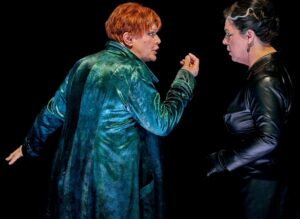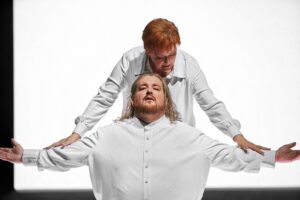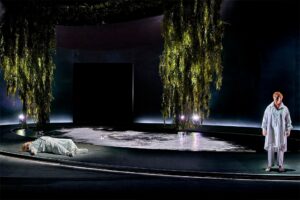I remember a conversation with a University of Göttingen professor who in 2019 spoke of the imminent death of the Wagner Festival in Bayreuth, an event that, in his view, was anachronistic, cultivated nineteenth-century rituals of art reception and, despite its attempts to woo younger audiences, completely ruled out any in-depth reflection on the composer’s work. His predictions nearly came true just a year later, when the Festspielhaus slammed its doors shut – for the first time in its post-war history. The festival rose back in convulsions from the devastations of the pandemic. In 2021 the organisers had to cancel the new production of Ring and resign themselves to presenting all performances with the house half full. Last season Katharina Wagner still had to take into account the risk of cancelling performances involving a large chorus and a large cast of soloists. In order to prevent any downtime, she commissioned Roland Schwab to prepare a “spare” staging of Tristan and Isolde to fill gaps in the repertoire, if it became necessary.
Making his Bayreuth debut, Schwab accepted the offer without a second thought, despite the fact that he had to deliver the commission in record time. The offer came in December 2021: given the unique scheduling of the preparations for the Green Hill premieres, the director presented a preliminary version of his concept just a month later. He took into account in it the “Covid” distance between the singers. The relatively sparse sets were designed by Piero Vinciguerra, the costumes by Gabrielle Ruprecht, while the lighting was directed by Nicol Rungsberg. In many respects the new production of Tristan appealed to the sensibility and sense of aesthetics of older, more experienced Wagnerites. The oval space above the stage, matched by an analogous shape on the stage floor, brought to mind not only Wieland Wagner’s legendary stagings, but also Vera Nemirova’s Frankfurt Ring. Restrained stage gesture, limited props, and lights emphasising the stark contrast of black and white completed the impression of asceticism of the whole.
Catherine Foster (Isolde) and Christa Mayer (Brangäne). Photo: Enrico Nawrath
After Valentin Schwarz’s mercilessly booed Ring, the new Tristan was received like an answer to everyone’s prayers. The staging had only two performances – despite constant cast changes, the festival programme went on as originally planned. This year Tristan returned to the Festspielhaus and was again very well received, although Schwab’s concept is not flawless. And yet – compared with the avalanche of trashy ugliness sweeping across most European stages – it fulfils the promise made by the director even before the premiere: that this would be a show in which the spectators would not want to find themselves, but, on the contrary, lose themselves.
From the beginning Schwab tries to convince us that Tristan is essentially a story with a happy ending, a tale of the power of true love all the way to the grave and beyond. To highlight this trope, he resorts to some questionable solutions, however. One them is an allusion to Wagner’s alleged Buddhist inspirations – in the form of a neon sign in the Devanāgarī script, which accompanies us throughout the performance with the Sanskrit word śāśvata, which means more than “eternal” (because it also means primordial, recurring, continuous, lasting forever), and is essentially at odds with the Buddhist message rejecting the errors of both nihilism and eternalism. The word śāśvata refers precisely to the eternalist belief in the real existence of phenomena as they appear to manifest themselves. Thus, it fits neither the Buddhist worldview nor the message of Wagner’s opera. Doubts are also raised by the fact that the story of Tristan and Isolde has been linked to the late ancient myth of Philemon and Baucis, first told in the eighth book of Ovid’s Metamorphoses. After all, the story of two Phrygian villagers who were the only people to take under their roof Zeus and Hermes – disguised as poor wanderers – and as a reward for their generosity were transformed posthumously into two trees with intertwined branches, is about love that is fulfilled and lasting. Nor am I convinced by Schwab’s argument that the fate of Tristan and Isolde was similarly summarised by the thirteenth-century German writer Ulrich von Türheim in his completed version of Gottfried von Strassburg’s poem. Let me say once again that Wagner’s Tristan is neither an autobiographical work, nor an operatic adaptation of a medieval romance.
Catherine Foster and Clay Hilley (Tristan). Photo: Enrico Nawrath
This does not change the fact that Schwab’s production reaches the realm of the metaphysical and transcendent in many respects. First of all, this is because of the clear separation of the oval on the stage floor from the rest of the theatrical space. That place, which at the beginning of Act I brings to mind vague associations with a swimming pool aboard a luxurious cruise ship, can be accessed only by the protagonists and only from the moment of their amorous confession. However, something strange happens earlier, when the water turns red at the sound of Isolde’s story about the death of the brave Morold. The oval shape gradually draws both protagonists in, like a dizzying whirl of passion. Yet it does not allow them to become united, either in Act II, when their great duet, begun on a surface in which the light of stars is reflected, ends in a desperate struggle of contrasts between the dazzling World of Day and the fathomless, ink-black World of Night; or in the finale of Act III, when the oval freezes into a silvery-grey, motionless pond. A strong idea – though interpreted by some spectators as an allusion to the practices of totalitarian systems – was to have Tristan mortally wounded by strands of white light descending from the flies. This execution, as it were, resembling death in the electric chair, was preceded by tortures inflicted on the lovers by the jealous Melot, who shone a spotlight in their eyes – a moving symbol of the world from which they both wanted to escape into the night.
In the face of so much magnificence, it is not hard to forgive the director for having the transformed Isolde/Baucis begin her final monologue from behind a thicket of green leaves; it is also possible to turn a blind eye to the idea of bringing on stage three pairs of the lovers’ alter egos embodying the youthful, mature and old ages of their love. Especially given that Markus Poschner dressed the whole thing in a surprisingly subtle musical garment sparkling with flashes of bright orchestral colours (excellent woodwind!) against the dark sounds of instruments in the lower register, constructing the narrative with the method of persistent gradation of tensions. If anything can be said against him, it’s the occasional unstable proportions between the stage and the covered orchestra pit, which was especially problematic for Tristan in Act II. The American tenor Clay Hilley, who stepped in for Stephen Gould at the last moment, has a voice that is slightly smaller and less developed at the top; in addition, he does not always know how to cover minor technical deficiencies with expressive text delivery. However, it must be said that his phrasing is sensitive and elegant enough for him to possibly join the ranks of the best “lyrical” Tristans in the world in a few seasons. Catherine Foster, endowed with a harsh, but assured and perfectly placed soprano, confirmed her class as Isolde: it is a pity that she ran out of steam for the final “Mild und leise wie er lächelt”, for which she paid with too wide a vibrato and several intonation lapses. Christa Mayer did well as Brangäne, although her singing lacked the softness characteristic of the best performers of the role. I found Ólafur Sigurdarson (Melot), who possesses a rather gravelly baritone, more convincing as an actor. Jorge Rodríguez-Norton (Shepherd), Raimund Nolte (Steersman) and Siyabonga Maqungo (Young Sailor) handled their respective episodic roles efficiently.
Clay Hilley and Catherine Foster. Photo: Enrico Nawrath
However, complete understanding of the text, both literary and musical, was demonstrated only by Markus Eiche (a surprisingly fragile Kurwenal, with a baritone voice that is bright and melancholy in tone), and above all by Georg Zeppenfeld in the role of King Marke. His extraordinarily handsome bass, phenomenal diction and unfailing sense of the stage were as usual appreciated by the audience, who rewarded their favourite with a roar of applause.
And so Tristan, as presented by Roland Schwab, again served to wipe away the tears of music lovers disappointed with the new Ring, which reportedly somehow failed to settle. I was about to say that makeshift solutions sometimes proved to be the most durable, but not this time – the staging has been removed from the repertoire for good; next season it will be replaced by a new production by the Icelandic director Þorleifur Örn Arnarsson, with an almost completely different cast conducted by Semyon Bychkov. This was not the end of the festival surprises, especially for fans of good singing. The rumours of the Bayreuther Festspiele’s death turned out to be greatly exaggerated.
Translated by: Anna Kijak



